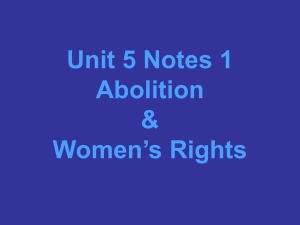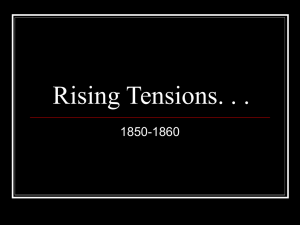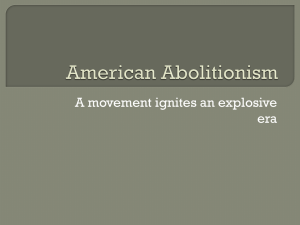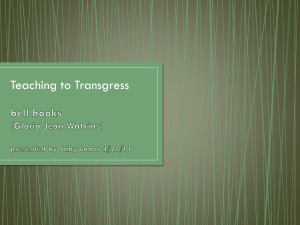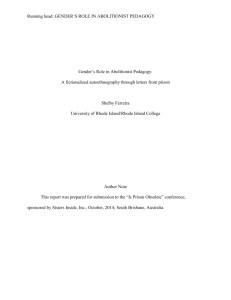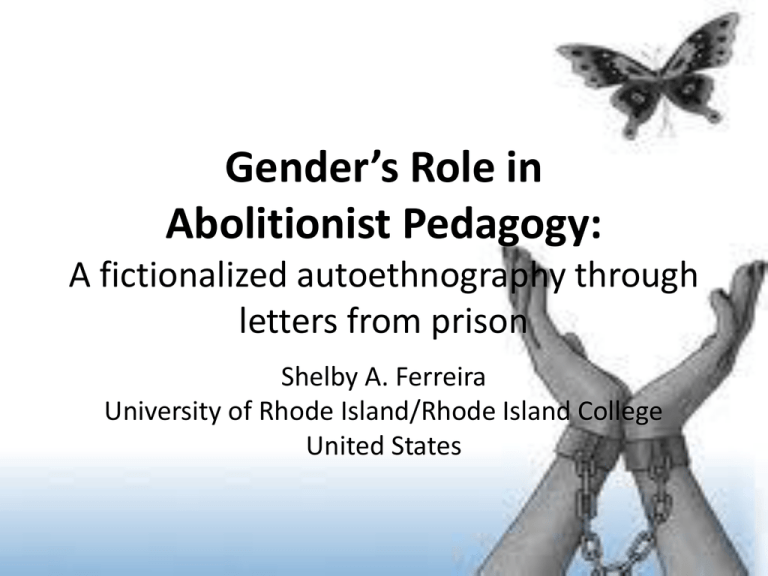
Gender’s Role in
Abolitionist Pedagogy:
A fictionalized autoethnography through
letters from prison
Shelby A. Ferreira
University of Rhode Island/Rhode Island College
United States
Problem
• Prison-based education, the antidote to the
US’s epidemic of mass incarceration, faces
many challenges. Gender plays a role in those
challenges, yet its role is not well researched.
Thus, an exploration of gender’s role in
abolitionist pedagogy is in order.
Significance
• US epidemic of mass incarceration
• Within prisons exist experts with potential
cure this epidemic
• Prisons “integral to understanding the larger
constellation” of societal ills (Vaught, 2012)
• Recursive effect on greater society
• Instead of dumping grounds
• Vehicles for transformation
Autobiographical Information
•
•
•
•
•
Commitment to most vulnerable populations
Prison abolitionist
Ex-prison educator
University Affirmative Action administrator
Educational researcher
Terms of Interest
•
•
•
•
Abolitionist pedagogy
Autoethnography
Gender
Humanistic
Background
• US has world’s highest incarceration rates
(Alexander, 2010; Glaze & Herberman, 2013)
• Astronomical re-incarceration rates (Esperian, 2010)
• Decreases associated with prison-based
education (Davis, Bozick, Steele, Saunders, & Miles, 2013; Esperian, 2010)
• Cultural transmission model dominates (Burton-Rose &
Wright, 1998; Kohlberg & Mayer, 1972; Williford, 1994)
Background
• Further decrease associated with prison-based
humanistic education (PBHE) (Davis, et al., 2013; Esperian,
2010; Frank, Omstead, & Pigg, 2012; Nally, Lockwood, Knutson & Ho, 2012; Palmer, 2012;
Rafay, 2012; Steurer, Linton, Nally & Lockwood, 2010; US. Department of Education, 2012;
Vaught, 2012; Ward, 2009; Warner, 2007)
• PBHE suggests abolitionist potential (Larson, 2011; Scott
1998)
• Institutional challenges to abolitionist
pedagogy (Ferreira, 2013; Kilgore, 2011)
• Role of gender in challenges to abolitionist
pedagogy(Ferreira, 2013)
My Experience
• Gender-relevant, context-specific, critical, democratic
pedagogy within a women’s medium-security prison
– Sexual abuse
– Patriarchy
– Psychiatric drugs
• Context-specific, critical, democratic pedagogy within a
men’s maximum-security prison
– Hyper-masculinity
– Conformity to inherited penal system
• Termination
– Hyper-sexualization
• All the Way Home
– Criminalization
Purpose
• In-depth exploration of gender’s role in the
perception, implementation, and effects of
abolitionist pedagogy
• Amplify the voices of incarcerated experts
Theoretical Framework
• Social reconstruction ideology
(Schiro, 2012)
– Society unhealthy
– Education as means to envision a new one
• Prison abolition ideology
(Davis, 2003)
– Just & equitable society doesn’t need prison
– Restorative justice
• Critical feminist theory (Butler, 1990; Rhode, 1989)
–
–
–
–
Gender inequity
Gender roles
Sexualization
Hetero-normativity
Review of the Literature
• Prison-based education (Burton-Rose & Wright, 1998; Davis, Bozick, Steele,
Saunders, & Miles, 2013 ; Esperian, 2010; Jones & d’Errico, 1994; Kilgore, 2011; Kohlberg & Mayer, 1972;
Williford, 1994)
• Prison-based humanistic education [PBHE] (Bordt
& Carceral, 2012; Davis, et al., 2013; Esperian, 2010; Frank, Omstead, & Pigg, 2012; Halperin,
Kessler, & Braunschweiger, 2012; Hartnett, 2011; Kilgore, 2011; Larson, 2011; Lee, 2010;
Lockard & Rankins-Robertson, 2011; Nally, Lockwood, Knutson & Ho, 2012; McCarty, 2006;
Olinger, et.al, 2012; Palmer, 2012; Rafay, 2012; Shieh, 2010; Steurer, Linton, Nally &
Lockwood, 2010; US. Department of Education, 2012; Ward, 2009; Warner, 2007 Williford,
1994)
• Abolitionist pedagogy (Hartnett, 2011; Kilgore, 2011; Larson, 2011;
Palmer, 2012; Wright, 2004)
• Gender & institutions (Brown, 2005; Connell, 1996; Davis, 2003; Lempert,
Bergeron, & Linker, 2005; Martin, 1994; Rowe, 2004)
Research Question
• Gap in literature: Role of gender in abolitionist
pedagogy
• What role does gender play in the perception,
implementation, and effects of abolitionist
pedagogy?
Methodology
• Pragmatic (Biesta & Burbules, 2003)
– Find means to achieve educational ends
– My expertise
)
• Qualitative (Maxwell, 2005; Patton, 2002)
– Exploratory
• Autoethnographic
– Culture
– Personal expertise
(Chang, 2008)
Data Sources
• Observational/Self-Reflective (Chang, 2008)
–
–
–
–
Field journal
Personal journal
Personal art/creative projects
Analytic memos
• External
– Texts generated from incarcerated students
– Interviews & field notes from All the Way Home
– Letters/art/other incidental documents from
incarcerated loved ones/acquaintances
Data Analysis and Transformation
Procedure
(Chang, 2008)
Ethical Considerations
• Confidentiality
• Responsibility to students/participants
Presentation of Findings
• Fictionalized accounts (Greene, 1988; Sconiers, 2000)
– De-identifying data, confidentiality
– Question values
• “Letters from prison”
– Counternarrative (Bamburg & Andrews, 2004; Baszile, 2005)
– Form (Barone, 2001; Greene, 1998)
Preliminary Findings/Implications
• Findings:
– Gendered culture/institution as barrier to
abolitionist pedagogy
– Incarcerated people have solutions
• Implications:
– Communities of practice, incarcerated people,
prison personnel, educators
Suggestions for Future Research
• Roles of race/ethnicity, economics, etc. in
abolitionist pedagogy?
• How might we use our knowledge of the role
of gender in prison-based education in order
to better align with an abolitionist vision?
References
(Available upon request)
Thank you!
• Questions/feedback?


